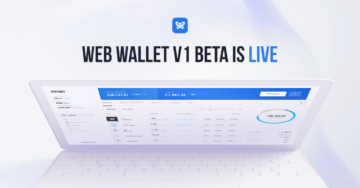
In the rapidly evolving landscape of blockchain and decentralized finance (DeFi), the Pyth Network stands out as a revolutionary platform. Launched in 2021 by a group of visionary developers from prominent institutions like Jump Crypto, Pyth Network addresses a critical need in the blockchain world: the provision of accurate, real-time pricing data.
Designed to democratize access to professional-level financial data, Pyth Network is changing how information is shared and used in the blockchain space, making it more accessible to a wider audience, including casual crypto enthusiasts and developers.
Background
Launched in 2021, Pyth Network emerged from the collective efforts of a skilled team of developers, many of whom honed their expertise at Jump Crypto and various decentralized finance (DeFi) institutions. The inception of Pyth Network was driven by a clear recognition of a gap in the blockchain ecosystem – the lack of accurate and real-time pricing data accessible to users, particularly for use in smart contracts.
The team behind Pyth Network was motivated by the challenge of democratizing access to high-quality data within the crypto space. Their vision was to develop a platform that could level the playing field, providing casual crypto enthusiasts with the same caliber of professional-level data feeds that were typically reserved for more seasoned players in the field. This aspiration laid the foundation for what Pyth Network aimed to achieve – a transformative solution in the blockchain and DeFi landscape.
What is Pyth Network?
Pyth Network stands as a groundbreaking decentralized protocol, fundamentally redefining the accessibility of high-quality financial data within the blockchain realm. It addresses a long-standing imbalance in the availability of crucial financial information — such as stock and commodity prices, along with currency exchange rates — which has traditionally been the purview of institutional entities like banks and hedge funds.
Breaking away from this conventional model, Pyth Network extends the reach of this vital data to a much wider audience. This includes not just individual users, but also developers and decentralized finance (DeFi) applications, thereby democratizing access to information that was once exclusive.
At its core, Pyth Network serves as a bridge, linking the often segregated data reservoirs of traditional finance with the decentralized, transparent nature of blockchain technology. This integration fosters a more inclusive, transparent, and equitable environment for financial data access, marking a significant step forward in blending traditional financial data sources with the emerging blockchain ecosystem.
How Does Pyth Network Work?
Pyth Network was developed to address critical limitations inherent in traditional oracle systems used for financial data distribution. Traditional models operated under the assumption that all data, including financial information, was readily available and could be easily retrieved and brought onto the blockchain by incentivizing network participants. This approach involved collecting data from public sources and aggregators, which often led to compromises in data quality, costs, and scalability for financial data, largely due to intellectual property (IP) laws.
In contrast, financial data in the traditional exchange industry is highly valued, as evidenced by the substantial revenues generated from data fees. The industry’s reliance on paid subscriptions for professional data terminals (like Bloomberg) and the move of even crypto exchanges towards charging for market data underscore this point. Consequently, non-paywalled data available to free users is often delayed or aggregated by services not optimized for smart contracts, leaving DeFi users with suboptimal information.
Innovative Approach
Pyth Network introduces a new model for financial data distribution that recognizes the intrinsic value of this information. Rather than approximating data, Pyth incentivizes the direct contribution of data by its original owners – the “first-party” data sources. This structure allows Pyth to function as a decentralized marketplace for market data, where data creators supply proprietary information and applications using this data act as consumers. This model is akin to platforms like Airbnb, which unlocked new resources for the travel industry; Pyth does the same for high-quality blockchain data.
The network’s first-party data model is designed to cater to the expanding DeFi market, including new asset classes such as energy, treasury rates, and real-world assets, which lack free online equivalents. The rights associated with Pyth’s first-party data providers position the network to adapt to DeFi’s growth and the emergence of new markets.
Role in the DeFi Ecosystem
With over 90 first-party data sources publishing directly, Pyth Network operates as the largest publisher oracle network in the blockchain space. Nodes in this network own and publish their data directly on-chain, allowing for free distribution across the blockchain and beyond. This model maximizes access to information and reduces middlemen costs for data consumers. It also provides speed and cost advantages, enabling Pyth to scale to thousands of symbols and cover near-limitless blockchains.
The architecture of Pyth Network is analogous to Spotify’s approach in the music streaming industry. Just as Spotify streamlined music distribution by allowing direct streaming from musicians and record labels, Pyth acknowledges and rewards the owners of financial data, creating a more efficient and equitable data distribution system for the blockchain era.
Main Components
Pyth Network’s infrastructure is composed of several critical components that work together to provide reliable and accurate financial data within the blockchain ecosystem.
Data Providers
At the forefront of the Pyth Network are the Data Providers, who form the backbone of the system. These providers include a diverse array of entities such as global exchanges, trading firms, market makers, and other institutional and decentralized market participants. They supply proprietary data to the network, specializing in two main types of price data: tradeable asset prices sourced from exchanges and the latest transaction prices from traders. This direct contribution from a variety of sources ensures the richness and reliability of the data within Pyth.
Pyth Protocol
Central to Pyth Network is the Pyth Protocol, an advanced system designed to aggregate data from its various providers. This protocol is responsible for creating a unified price and confidence interval for each price feed, updated every 400 milliseconds. The data aggregation process takes place on an application-specific blockchain, Pythnet, which operates as a proof-of-authority chain. This configuration ensures the robustness and accuracy of the data, making it a trustworthy source for users.
Data Users
The ultimate recipients of Pyth Network’s aggregated price feeds are the Data Users – applications on Pyth-supported blockchains. These end-users read the aggregated price feeds and integrate this data into their smart
$PYTH Tokens
The Pyth Network ecosystem is underpinned by its native cryptocurrency, the PYTH token. This token is integral to the network’s functionality, serving as the primary mechanism for coordinating and incentivizing the activities of various participants within the ecosystem.
PYTH tokens are designed to align the interests of different stakeholders, including data publishers, data consumers, and delegators. By using these tokens as a central element of the network’s crypto-economic structure, Pyth ensures that all participants are motivated towards the common goal of maintaining and enhancing the network’s efficiency and reliability.
Functions and Utility
In terms of practical utility, PYTH tokens are employed in several key functions within the Pyth Network:
- Data Staking: Stakeholders use PYTH tokens to stake on data, which plays a crucial role in validating and securing the information within the network.
- Rewards Distribution: PYTH tokens are used to distribute rewards within the network, providing economic incentives for participants who contribute valuable data and services.
- Governance: Holding PYTH tokens gives stakeholders a say in the governance of the network. This includes making strategic decisions about the network’s future direction, protocol upgrades, and other key operational aspects.
Conclusion
Pyth Network represents a significant leap forward in the blockchain and DeFi ecosystems. By providing high-quality financial data through a decentralized protocol, it empowers a diverse range of participants, from individual users to large-scale DeFi applications.
The introduction of PYTH tokens further strengthens this ecosystem, aligning the interests of various stakeholders and paving the way for effective network governance and strategic decision-making. As the network continues to evolve, Pyth Network is poised to play a crucial role in the future of decentralized finance, offering transparency, inclusivity, and innovation.
- SEO Powered Content & PR Distribution. Get Amplified Today.
- PlatoData.Network Vertical Generative Ai. Empower Yourself. Access Here.
- PlatoAiStream. Web3 Intelligence. Knowledge Amplified. Access Here.
- PlatoESG. Carbon, CleanTech, Energy, Environment, Solar, Waste Management. Access Here.
- PlatoHealth. Biotech and Clinical Trials Intelligence. Access Here.
- Source: https://www.asiacryptotoday.com/pyth-network/
- :has
- :is
- :not
- :where
- 2021
- 400
- 90
- a
- About
- access
- accessibility
- accessible
- accuracy
- accurate
- Achieve
- across
- Act
- activities
- adapt
- address
- addresses
- advanced
- advantages
- aggregate
- aggregation
- Aggregators
- aimed
- Airbnb
- align
- aligning
- All
- Allowing
- allows
- along
- also
- an
- and
- applications
- approach
- architecture
- ARE
- Array
- AS
- asia
- Asia Crypto Today
- aspects
- aspiration
- asset
- Assets
- associated
- assumption
- At
- audience
- availability
- available
- away
- Backbone
- background
- Banks
- BE
- been
- behind
- Beyond
- blending
- blockchain
- blockchain data
- blockchain ecosystem
- Blockchain space
- blockchain technology
- blockchains
- Bloomberg
- BRIDGE
- brought
- but
- by
- casual
- cater
- central
- chain
- challenge
- changing
- charging
- classes
- clear
- Collecting
- Collective
- commodity
- commodity prices
- Common
- components
- composed
- conclusion
- confidence
- Configuration
- Consequently
- Consumers
- continues
- contracts
- contrast
- contribute
- contribution
- conventional
- coordinating
- Core
- Cost
- Costs
- could
- cover
- Creating
- creators
- critical
- crucial
- crypto
- crypto enthusiasts
- Crypto Exchanges
- crypto space
- cryptocurrency
- Currency
- data
- data access
- data quality
- decentralized
- Decentralized Finance
- decentralized finance (DeFi)
- decentralized marketplace
- Decision Making
- decisions
- DeFi
- DeFi ecosystems
- DeFi landscape
- DeFi Market
- Delayed
- democratize
- Democratizing
- designed
- develop
- developed
- developers
- different
- direct
- direction
- directly
- distribute
- distribution
- diverse
- does
- driven
- due
- each
- easily
- Economic
- ecosystem
- Ecosystems
- Effective
- efficiency
- efficient
- efforts
- element
- emerged
- emergence
- emerging
- employed
- empowers
- enabling
- end
- energy
- enhancing
- ensures
- enthusiasts
- entities
- Environment
- equitable
- equivalents
- Era
- Even
- Every
- evidenced
- evolve
- evolving
- exchange
- Exchanges
- Exclusive
- expanding
- expertise
- extends
- Fees
- field
- finance
- financial
- financial data
- financial information
- firms
- For
- forefront
- form
- Forward
- fosters
- Foundation
- Free
- from
- function
- functionality
- functions
- fundamentally
- funds
- further
- future
- gap
- generated
- gives
- Global
- goal
- governance
- groundbreaking
- Group
- Growth
- hedge
- Hedge Funds
- high-quality
- highly
- holding
- How
- HTTPS
- imbalance
- in
- Incentives
- incentivizes
- incentivizing
- inception
- include
- includes
- Including
- Inclusive
- Inclusivity
- individual
- industry
- industry’s
- information
- Infrastructure
- inherent
- Innovation
- Institutional
- institutions
- integral
- integrate
- integration
- intellectual
- intellectual property
- interests
- into
- intrinsic
- Introduces
- Introduction
- involved
- IP
- IT
- ITS
- jump
- Jump Crypto
- just
- Key
- Labels
- Lack
- landscape
- large-scale
- largely
- largest
- latest
- launched
- Laws
- Leap
- leaving
- Led
- Level
- like
- limitations
- linking
- long-standing
- Main
- maintaining
- Makers
- Making
- many
- Market
- Market Data
- market makers
- marketplace
- Markets
- marking
- maximizes
- mechanism
- middlemen
- milliseconds
- model
- models
- more
- more efficient
- motivated
- move
- much
- Music
- music streaming
- musicians
- native
- Nature
- Need
- network
- New
- nodes
- of
- offering
- often
- on
- On-Chain
- once
- online
- onto
- operated
- operates
- operational
- optimized
- or
- oracle
- original
- Other
- out
- over
- own
- owners
- paid
- participants
- particularly
- Paving
- Place
- platform
- Platforms
- plato
- Plato Data Intelligence
- PlatoData
- Play
- players
- playing
- plays
- Point
- poised
- position
- Practical
- price
- price feed
- Prices
- pricing
- primary
- process
- professional
- prominent
- property
- proprietary
- protocol
- protocol upgrades
- provide
- providers
- provides
- providing
- provision
- public
- publish
- publisher
- publishers
- Publishing
- Pyth
- pyth network
- quality
- range
- rapidly
- Rates
- rather
- reach
- Read
- readily
- real world
- real-time
- realm
- recipients
- recognition
- recognizes
- record
- Redefining
- reduces
- reliability
- reliable
- reliance
- represents
- reserved
- Resources
- responsible
- revenues
- revolutionary
- Rewards
- rights
- robustness
- Role
- same
- say
- Scalability
- Scale
- seasoned
- securing
- segregated
- serves
- Services
- serving
- several
- shared
- significant
- skilled
- smart
- Smart Contracts
- solution
- Source
- sourced
- Sources
- Space
- specializing
- speed
- Spotify
- stake
- stakeholders
- stands
- Step
- stock
- Strategic
- streaming
- streamlined
- Strengthens
- structure
- subscriptions
- substantial
- such
- supply
- system
- Systems
- takes
- team
- Technology
- terms
- than
- that
- The
- The Future
- the information
- their
- theme
- thereby
- These
- they
- this
- thousands
- Through
- to
- today
- together
- token
- Tokens
- towards
- tradeable
- Traders
- Trading
- traditional
- traditional finance
- traditionally
- transaction
- transformative
- Transparency
- transparent
- travel
- travel industry
- treasury
- trustworthy
- two
- types
- typically
- ultimate
- under
- underpinned
- underscore
- unified
- unlocked
- updated
- upgrades
- use
- used
- users
- using
- utility
- validating
- Valuable
- value
- valued
- variety
- various
- vision
- visionary
- vital
- was
- Way..
- were
- What
- What is
- which
- WHO
- whom
- wider
- with
- within
- Work
- work together
- world
- zephyrnet









